|
|
|
|
More fun with random boundaries |

|
|---|
|
initial
Figure 1. A zoom-in on the wave-field as it propagates into the random boundary. The order in time is top-left, top-right, bottom-left, bottom-right. Note how very little of the wavefront is perturbed at early times. |
|
|

|
|---|
|
different
Figure 2. A zoom in on the wave-field as it passes into the random boundary. The three panels represent three different random boundaries. Note the differences in the wave-field leaving the boundary. |
|
|
|
stack1
Figure 3. The result of stacking 16 different random realizations. Note how the noise introduced by the random boundary cancels out when summed. |

|
|---|---|
|
|
Figures 1-3 are somewhat misleading because the source is in the middle of the computational domain. Figure 4 shows a more realistic scenario where the shot is at the edge of the computational domain. Note the similarity in the wave-fields at early times even with different randomized boundaries. As a result, reflections at these early times (at shallow depths) show many more artifacts than those at later times (Figure 3).

|
|---|
|
edge
Figure 4. The left and center panels show the wave-field at the same time with two random boundaries generated using algorithm 1. The right panel shows the result of adding 16 realizations together. Note how some energy was stacked coherently. |
|
|
The shallow depth image can be improved by modifying the random velocity boundary.
Algorithm 2 introduces a decreasing maximum velocity towards
the outer edge of the computational domain. Energy now takes
longer to leave the boundary creating a larger time gap and more
random energy pattern between the true wave-field
and the noise introduced by the boundary. Figure 5 shows
several snapshots with this new boundary condition. Note the increased
separation in time and space (compared to the wave-fields seen in Figure 1).
The increased time gap and randomness produces less noise at shallow depths
(Figure 6).


|
|---|
|
decrease
Figure 5. The left and center panels show the wave-field at the same time with two random boundaries generated using algorithm 2. The right panel shows the result of adding 16 realizations together. Note how some energy was stacked coherently. Note the larger gap in time between the main wavefront and the energy generated from the random boundary. Further note the decreased energy in the result of stacking multiple realizations. |
|
|

|
|---|
|
improved
Figure 6. The result of migrating using a damped boundary condition(A), the boundary condition described in algorithm 1 (B), and the boundary condition described in algorithm 2 (C). Note how the shallow reflectors are preserved in (C). |
|
|
|
|
|
|
More fun with random boundaries |